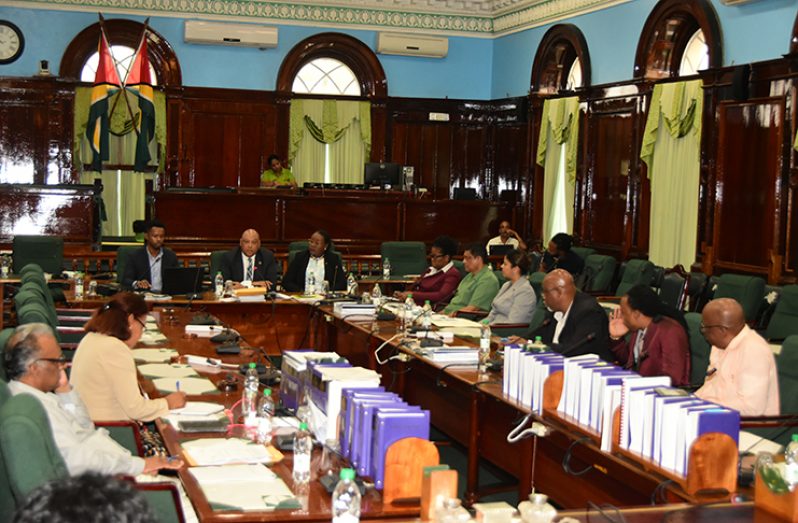– Min Trotman reiterates security considerations guided decision
CONCESSIONS granted by the Government of Guyana to U.S. oil giant ExxonMobil in its 1999 agreement, which was subsequently revised in 2016 will remain “intact” Minister of Natural Resources, Raphael Trotman told the Parliamentary Sectoral Committee on Natural Resources on Friday.
In an update on the performance of his ministry, Trotman told the Committee chaired by Opposition Member of Parliament (MP) Odinga Lumumba, that the 1999 agreement between the government and ExxonMobil was strategically crafted.
He disclosed that security reasons formed the basis of the government’s decision to grant ExxonMobil concessions from “tip to tip” representing Barima Waini, located in Region One to the Corentyne, located in Region Six.
Trotman reminded the committee of Venezuela’s threat to Guyana’s sovereignty and noted that decisions made were informed by the “happening of events in the West”, as he demonstrated Venezuela’s claims via a map during a PowerPoint presentation. In May 2015, just after the APNU+AFC coalition government had won the general and regional elections, Venezuela had issued a Presidential Decree No. 1787 claiming the territorial waters in the Atlantic Ocean off the Demerara Coast to include the Liza well located 123 miles off the Mahaica coast.
That decree was made a few weeks after ExxonMobil and its partners Hess and CNOOC Nexen announced a significant discovery at Liza-1 well. “Venezuela’s decree put us in a serious national security situation,” said Trotman, who stressed that the 1999 contract with the oil company had strategically given ExxonMobil, “the length and breadth…from tip to tip of the two boundaries of Guyana.”
“This was not a coincidence; it was deliberate that we needed a partner in 1999 to cover the entire sea space from tip to tip…an American company,” the Minister added, noting that “we believe that those circumstances did not diminish or disappear.”
STRATEGIC MOVE
He said it was critical for Guyana to work with a company that has “international gravitas” and as such it was strategic to ensure that “the Exxon Block remain intact as it was in 1999”. Venezuela subsequently withdrew that claim following diplomatic pressure. In 1999 the Government of Guyana sought partnerships with American Companies, Beal Aerospace and Exxon. The Beal Deal was not completed but Exxon’s was. However, after the change in government in 2015, the new administration had re-negotiated the 1999 contract with ExxonMobil. The government through discussions with Exxon officials had two primary objectives, to start production in the earliest possible time (2020) and to protect the country’s resource.
In so doing, Trotman made it clear that there had been no breach of the 1999 agreement between the parties, neither did the contract expire. He said both parties voluntarily agreed to engage in a process of updating the 1999 agreement, while noting that the template used for the update was the 2012 model developed and used previously by the Government for Anadarko Petroleum Corp.
“We recognised one, the sanctity of the agreement that the agreement was based on strategic reasons and those strategic reasons did not diminish after the discovery in 2015; they did not disappear – in fact it deepened because Venezuela strengthened its claim against Guyana. It was important therefore that we see everything done in that context.”
Chairman of the Parliamentary Sectoral Committee on Natural Resources, Odinga Lumumba, called on Minister Trotman to outline to the committee the fundamental differences between the 1999 and 2016 agreement. Trotman said while the differences are few, a new feature to the agreement included the presence of a signature bonus. Government in 2016 received US$18M as a signature bonus from ExxonMobil. Additionally, licensing fees have been increased from US$ 250,000 annually to US$1M annually while the parties have introduced an annual payment for Corporate Social Responsibility (CSR) for projects, to be determined by both the government and the company.
STABILISATION CLAUSE
A different stabilisation clause was also included in the 2016 agreement. That clause is identical to that found in the agreement with the American company, Anadarko, whose research vessel was seized by Venezuelan military officials in 2013. Trotman said foreign companies wanted to ensure that the government would not in the face of opposition or adversity forsake them. Venezuela had written to all of the oil companies operating offshore Guyana and that move scared many. The Minister said only few stood up, ExxonMobil being one of them. Profits to be gained from gas were also placed into the new agreement. According to the new agreement, 12.5 per cent during the cost recovery phase would go to the government and 50 per cent thereafter. The amount will be calculated based on production.
“We have not tried to renegotiate the fiscal terms; that has been kept intact,” Trotman added. Acreage provided to Exxon remains the same and Trotman told the committee that the law gives him the power to consider applications for the granting of more than 60 blocks, where he is satisfied that special circumstances exist for doing so.
The Natural Resources Minister told the bi-partisan committee that the threat to Guyana’s sovereignty was paramount in the mind of the administration, notwithstanding that economic considerations existed. He made it clear that Guyana was already going to earn 3.2B barrels of oil. “We were already going to be wealthy- we wanted to anchor Exxon into our waters to let them know we were a serious government, and to let them know we were serious about developing our resources,” he explained.
Lumumba questioned whether the existing agreement with Exxon allows for that company to release some amount of the blocks granted to it. “Because of national security reasons that is being delayed?” asked the Committee’s chairman. Trotman explained that after the 2013 incident with Anadarko it was believed that Exxon should have been allowed to hold on to the acreage given strategic security reasons.
“The decision not to release blocks in that area was strategic for national security?” Lumumba followed up, to which the Minister answered in the affirmative. Trotman disclosed that the government received advice from Sir Shridath Ramphal and former Foreign Affairs Minister, Rashleigh Jackson. The duo had advised the government in 1999.
The chairman then questioned whether other companies would be allowed to partner with ExxonMobil in areas allocated to the U.S. oil giant. “…If other companies want to partner with Exxon we will not interfere,” the Natural Resources minister said, noting that companies coming to operate in Guyana must understand that the natural resource is Guyana’s and will be developed by Guyana.
SIGNING BONUS
Meanwhile, on the question of the US$18M signing bonus, Trotman said after discussions with ExxonMobil, the company agreed to give Guyana support. US$15M of that sum has been earmarked for legal fees for Guyana’s challenge against Venezuela at the International Court of Justice (ICJ) over its territorial space, while the remaining US$3M will be used for capacity building for the period 2017-2020.
Lumumba queried whether the government used a formula in determining the quantum of the signing bonus. It was then that Minister Trotman disclosed that the method used to arrive at the signing bonus total resulted from the July 2000 incident involving CGX Energy. Then, the oil company attempted to explore towards the north eastern side of the country and gunboats from Suriname arrested the CGX drillship and stopped work. The matter was placed before the International Law of the Sea Tribunal and the fee, as advised, was in the vicinity of US$12M. That fee was said to have been paid by an oil company that had vested interest in assisting Guyana in the matter.
“With the benefit of that advice and the adjustments made, it was my understanding that the figure of US$15M was given as a fair figure that would cover expenses in the ICJ,” Trotman explained. “I assume there is a letter somewhere from Exxon to the Government of Guyana saying that we are granting this US$18M for this purpose?” asked Lumumba to which Trotman replied, “Sir, you will not find that [letter] in any office…the government asked for support from Exxon of a sum.” The minister made it clear that it is not ExxonMobil’s role to tell the government what it should do with the money received. “We determined that. We needed the sum of money for a particular purpose and that is to hire the best lawyers,” said Trotman who denied writing ExxonMobil on the matter.




.png)









